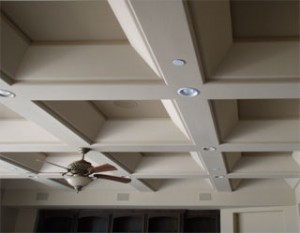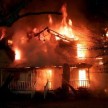Why Install Fire Sprinklers
 Fire Sprinklers
Fire Sprinklers
Fire sprinklers are your best chance of surviving a house fire. My prediction is during the next decade residential fire sprinkler systems will be more standard in home building and major remodels.
Just like the introduction of seat belt laws, vehicle airbags, anti-lock brakes and stability control systems have all worked their way into becoming a required safety technologies. Residential sprinkler systems will soon take it’s place as a primary life and property saving system.
Why Install Fire Sprinklers
Why are fire sprinklers required in some areas and not in others? Why are there variations in sprinkler requirements?
Fire sprinkler systems are installed in accordance with consensus standards developed through the National Fire Protection Association (NFPA). These standards are very specific in defining how sprinklers are to be installed in different types of occupancies and different hazard classifications.
The three primary standards that define the installation requirements are:
- NFPA-13 (Installation of Sprinkler Systems);
- NFPA-13R (Installation of Sprinkler Systems in Residential Occupancies Up to and Including Four Stories in Height);
- NFPA-13D (Installation of Sprinkler Systems in One-and Two-Family Dwellings and Manufactured Homes).
NFPA is known for setting “ best practice” standards. The standards are not law.
The requirements for the installation of fire sprinklers are adopted as law by state or local jurisdictions as a part of their building codes or local ordinances. At times, jurisdictions may vary some of the requirements contained in the NFPA documents. Differences in requirements will vary from city to city based on local changes made to the NFPA standards, or the year of the standard adopted by the local jurisdiction. For example, if one city adopts the 1999 NFPA-13 standard, and another city adopts the 2002 issue of the same standard, there will be differences.
How do sprinklers operate?
Automatic fire sprinklers are individually heat-activated and tied into a network of pipes thiat aare charged with water.
Heat from a fire raises the sprinkler temperature to its operating point (usually 155ºF), once thiw occurs a solder link in the sprinkler head will melt or a liquid-filled glass bulb will shatter to open that single sprinkler, releasing water directly over the source of the heat.
Once the water starts running through the sprinkler pipes an alarm is sounded and alert a monitoring company or the fire department.
Why are sprinklers so effective?
Sprinklers operate automatically in the area of fire origin, preventing a fire from growing undetected to a dangerous size while simultaneously sounding an alarm.
Automatic fire sprinklers keep fires small. The average fire in sprinkler protected building are handled by one or two sprinklers. Residential fire sprinklers work quickly to contain a fire and eliminate the poisonous gases released when products within the home burn.
Most fire related fatalities are the result of the inhalation of poisonous gases which result in death by asphyxiation.
According to the National Fire Protection Association, there is no record of more than two deaths resulting from a residential fire in a fully sprinklered building in the United States.
Why are sprinklers better than smoke detectors?
Sprinklers work because they eliminate human error. Familiarity with escape routes or emergency exits, waking up and heading a smoke alarm are all eliminated . They go to work immediately to reduce or extinguish the fire.
Sprinklers prevent the fast developing fires of intense heat that are capable of trapping building occupants.
Smoke is the danger:
Smoke, a by-product of fire, is generally the cause of death to building occupants. Sprinklers are designed to minimize smoke level until the fire department arrives and to allow occupants more time to exit under less stressed conditions.
How much does a fire sprinkler system cost?
For new residential construction, systems usually cost from $1.50 to $2.00 per square foot – less than the cost of a typical flooring upgrade.
How much does retrofit cost?
Retrofit installations in existing buildings can be expected to cost somewhat more than for new construction, depending on the difficulty of installation and other factors. A general rule of thumb is to add 50 percent to the average cost of an installation in a new build.
Fire Damage in Sprinklered vs. Unsprinklered Homes
The below photos demonstrate a fire sprinkler’s ability to contain fire and limit damage. The fire began in the same location – behind the lounge chair – in both instances
Heat from fire quickly activated the fire sprinkler, located in the corner. The sprinkler limited damage to the curtains
No fire sprinklers present allowed the fire to reach flash over – instantly burning everything in the room.
| Time | What Is Happening |
| :00 | In the middle of the night, a fire starts somewhere in the home, immediately doubling in size approximately every minute through consumption of all available flammable materials. |
| 1:00 | A smoke alarm, if present, activates in the home. |
| 1:15 | A person awakened by the sound of the alarm is lucid enough to understand that there may be a fire and begins to investigate. |
| 1:30 | An emergency call goes into the fire department. |
| 2:00* | The temperature at the ceiling above the fire reaches 1,000 degrees Fahrenheit. |
| 2:15 | Poisonous gases and thick, black smoke begin to spread from the fire location to the rest of the home. |
| 3:00 | The fire department is dispatched. |
| 3:30 | The temperature at the ceiling now tops 1,400 degrees Fahrenheit. |
| 4:00 | Flashover, the point at which everything burns, occurs in the room where the fire originated. Nothing and no one survives flashover. Fire spreads uncontrollably throughout the house. |
| 4:30 | The fire department arrives on-scene and begins setting up equipment to fight the fire. This is considered an excellent response time and only occurs in areas that have an at-ready fire department. |
| 5:30 | The fire department begins throwing water on the fire – again, a best-case scenario. The fire continues to destroy the home until the fire department can get it under control. |
| *2:00 | If a residential fire sprinkler system is installed in the home, the sprinkler closest to the fire activates. It contains the fire (if not extinguishing it completely), keeping it from spreading until the fire department responds. Fire damage is controlled and lives are saved. |






